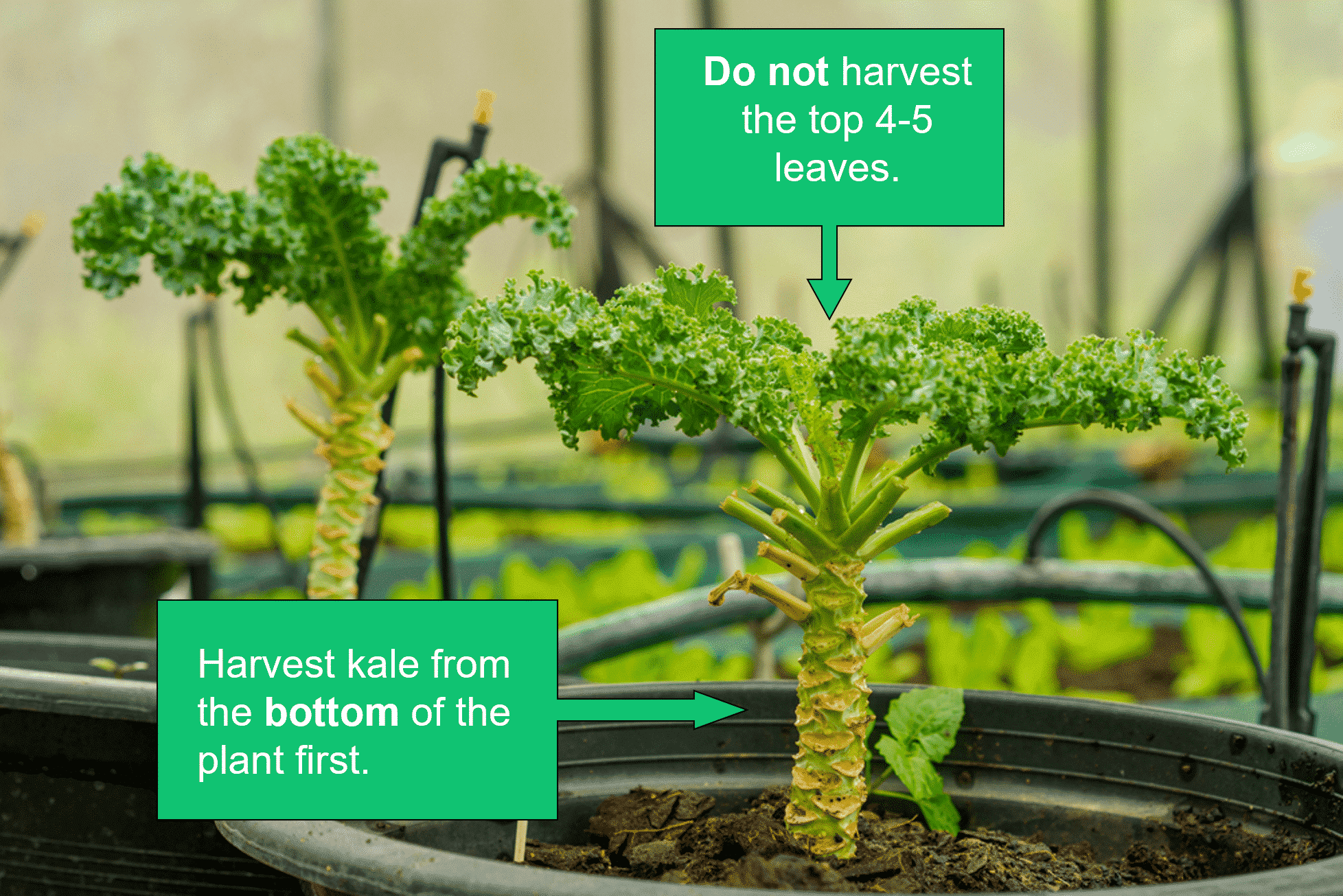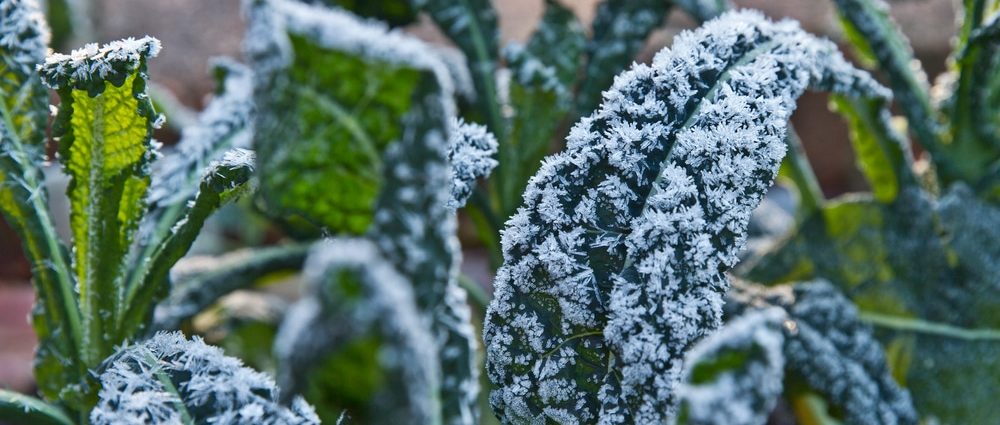
Kale is a wonderfully versatile plant that produces delicious harvests at every stage of its development. Most kale plants will reach maturity within 50-70 days of planting; however, you don’t have to wait that long to begin harvesting your kale. From microgreens to mature leafy greens, kale plants are almost always ready to harvest. Kale is a “cut and come again” plant that will continue to produce new leaves after each cutting. This means, you can harvest baby leaves from young plants and bigger leaves from mature plants without killing the plant. Here are our expert tips on harvesting kale:
Snapshot: When & How to Harvest Kale
How to Harvest:
- Gently cut or snap off the lowest leaves of the kale plant making sure to leave at least 4-5 leaves at the top of the plant.
- Wash kale leaves in cool water before eating to remove dirt, pests, and debris.
When is Kale Ready to Harvest:
Harvest kale when leaves have reached the desired size.
- Kale microgreens are ready to harvest in 7-10 days
- Baby kale greens are ready to harvest in 20-30 days
- Mature kale leaves are ready to harvest in 50-70 days
Best Time to Harvest:
- Kale tastes best when leaves are harvested in cooler weather (late spring-early summer & late fall – early winter)
- Harvest kale when the weather is cool in the early mornings before the afternoon sun.
General Kale Harvesting Tips
Recommended Products for Harvesting Kale
You don't have to be a gardening expert in order to harvest kale like a pro. While there are a few tricks and tips (listed below), all-in-all harvesting kale is simple---just remove a few tasty leaves anytime you are in the mood for some tasty kale. If you've done a good job growing your kale plants, then they should have big juicy leaves and be healthy enough to regrow new leaves quickly. However, if you kale plant is struggling after a harvest, be sure to give it a boost with some organic blood meal fertilizer before your next harvest to jumpstart leaf growth.
Tips for Harvesting Kale:
Harvest from Bottom to Top:
Start by cutting the lowest leaves of your kale plant first. These will be the most mature leaves on your plant.
Never Harvest Top Leaves:
Want your kale to continue growing new leaves? Then, do not harvest the leaves at the top of the plant. At least 4-5 top/center leaves should remain on the plant after each harvest.
Make a Clean Cut:
Prevent disease and plant damage by making sharp, clean cuts when removing kale leaves. Use a pair of harvesting shears or carefully snap leaves with your hand.
Cut Close to the Stalk:
Remove the majority of the leaf stems by cutting as close as you can to the main stalk without damaging the plant. Never cut the main plant stalk.
Discard Bad Leaves:
Discard any discolored, pest-infested, or badly damaged kale leaves. This will help to keep the plant healthy for future harvests.
Harvest Weekly:
Encourage new plant growth by consistently harvesting leaves from your kale plant each week. It's better to harvest a few leaves from your plant as you need them each week rather than scheduling one big harvest. Harvesting small batches at a time helps to encourage rapid regrowth.
How to Harvest Kale Without Killing the Plant?
Kale is a "cut and come again" plant which means it has the ability to grow new leaves after each harvest. To take advantage of this feature, all you have to do is avoid harvesting the top/center leaves of the kale plant (called the terminal bud). This central bud is where new kale leaves grow from and removing it will remove the plants ability to grow new leaves. The trick is to only harvest the lower-most leaves of the kale plant and leave 4-5 terminal bud leaves at the top of the plant to regrow.

How to Harvest Kale Microgreens & Baby Greens?
Kale can be harvested at any developmental stage from new sprouts to mature leaves. Kale microgreens and baby kale leaves are just as nutritious and delicious as the mature greens--but they can be harvested much sooner. On the downside, it takes a large amount of kale seeds to produce a meaningful microgreen or baby kale harvest. These methods can be expensive and inefficient compared to growing each kale seed to maturity and harvesting mature leaves.
Harvesting Kale Microgreens:
Harvest kale microgreens approximately 7-10 days after planting your seeds. Cut the microgreen stalks as close to the soil as possible. Microgreens are not "cut and come again" and will not regrow after harvest because the entire plant is harvested.
Harvesting Kale Baby Greens:
Harvest kale baby greens roughly 20-30 days after the plants have sprouted or when they are at least 5-10 inches tall. For a one-time harvest, remove all of the edible leaves. For a continuous harvest, remove all but the top 3-4 leaves on each plant.
When to Harvest Kale?

The best time to harvest kale is after it has been kissed by a light frost. This is because kale leaves become sweeter when exposed to colder temperatures and bitter when exposed to hot temperatures. In fact, the flavor of your kale harvests will continue to sweeten as temperatures dip down to 20°F. Leaves become bitter as temperatures consistently stay above 90°F and the plant will begin to bolt. To avoid this, start your kale seeds in early spring and late summer to ensure that your plants will reach maturity during the cooler seasons. You can also harvest your kale in the early morning when the weather is dewy and cool.
How to Store & Preserve Kale
Kale is a versatile green that can be enjoyed fresh from the garden or months later as a frozen treat. It stores easily and can be preserved fresh for up to 7 days, frozen for up to 8 months, and dehydrated for up to one year. Here are some ideas on how to store your kale harvest:
Keep Kale Alive:
Dip the stems of your kale plants into a container of water like you would a bouquet of flowers. The stems will absorb water and prevent the leaves from wilting.
Storing Fresh Kale:
Thoroughly rinse and dry your kale harvest. Wrap a bundle of kale leaves in a moist paper towel and store in a storage bag in the refrigerator. This will keep the leaves crispy and fresh for about a week.
Freezing Kale:
Freezing kale can preserve your harvest for over a year. First, wash and thoroughly dry your kale. Then, chop the leaves into your desired size, place into a freezer bag, and keep frozen for later use. Frozen kale super flexible and makes a great addition to smoothies, soups, stews, casseroles, omelets, and much more.
Dehydrated Kale Powder:
Dehydrated kale powder is a unique and fun way to store kale long-term. To dehydrate, simply wash and thoroughly dry your kale before placing in a dehydrator or oven set to 125 degrees for 6 hours. Kale leaves are fully dehydrated when they are super crispy and can be easily crunched with your fingers. Grind the kale leaves into a powder using anything from a food processor to a pestle and mortar. Store in an air-tight container in a cool, dry place. Kale powder can be used as a nutritious boost to smoothies, sauces, soups, eggs, and anything else you can dream up.
- Salad Spinner: Wash and dry your kale leaves before you store in the freezer or fridge.
- Food Dehydrator: Perfect for creating dehydrated kale for kale powder.
- Refrigerator Storage Bags: Reusable 1 gallon bags for storing chopped or whole kale in the fridge.
- Freezer Storage Bags: Large storage bags for storing frozen kale.
How to Grow Kale for Big Harvests?
Want a big bountiful kale harvest? The secret to high-producing kale plants comes down to good nutrition, choosing the right kale variety, and knowing the ideal growing environment for kale to thrive. Getting a big kale harvest starts with buying good kale seeds. Fresh organic kale seeds from good lineages will produce strong plants. Be careful when selecting your kale seeds as some kale varieties are designed for purely ornamental purposes. Kale thrives when fed specific fertilizers and grown in a certain temperature range. For more information, check out our comprehensive guide on How to Grow Kale.
Frequently Asked Questions About Harvesting Kale
How Do You Harvest Kale So It Keeps Growing?
To harvest kale so that it continues to grow new leaves, harvest the bottom-most leaves first and do not remove the top 4-5 leaves on the plant.


